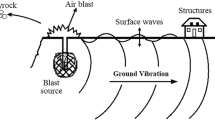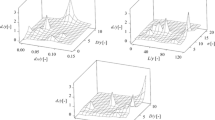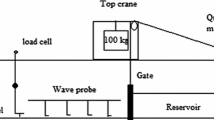Abstract
In order to measure the backhoe vibratory excavating resistance of a hydraulic excavator fast and precisely, the influences of vibratory excavating depth, angle, vibratory frequency, amplitude, bucket inserting velocity and soil type on the vibratory excavating resistance were analyzed. Simulation analysis was carried out to establish the bucket inserting velocity, amplitude and vibratory frequency considered as secondary variables and excavating resistance as primary variable. A fuzzy membership function was introduced to improve the anti-noise capacity of support vector machine, which is a soft-sensing model on the hydraulic excavator’s backhoe vibratory excavating resistance based on fuzzy support vector machine. The simulation result reveals that its maximum relative training and testing error are nearly 0.68% and −0.47%, respectively. It is concluded that the model has quite high modeling precision and generalization capacity, and it can measure the vibratory excavating resistance accurately, reliably and fast in an indirect way.
Similar content being viewed by others
References
SHAHGOLI G, FIELKE J, SAUNDERS C, DESBIOLLES J. Simulation of the dynamic behaviour of a tractor-oscillating subsoiler system [J]. Biosystems Engineering, 2010, 106(2): 147–155.
GUNN J T, TRAMONTINI V N. Oscillation of tillage implements [J]. Journal of Agricultural Engineering, 1995, 36(11): 725–729.
DEWANGAN K N, TEWARI V K. Characteristics of hand-transmitted vibration of a hand tractor used in three operational modes [J]. International Journal of Industrial Ergonomics, 2009, 39(1): 239–245.
ABU-HAMDEH N H. The disturbance of topsoil using ultrasonic waves [J]. Soil and Tillage Research, 2004, 75(1): 87–92.
NIYAMAPA T, SALOKHE V M. Soil disturbance and force mechanics of vibrating tillage tool [J]. Journal of Terramechanics, 2000, 37(2): 151–166.
NIYAMAPA T, SALOKHE V M. Force and pressure distribution under vibratory tillage tool [J]. Journal of Terramechanics, 2000, 37(2): 139–150.
WANG Chen, YING Fu-qiang. Intelligent control tactics of hydraulic excavator’s energy saving [J]. Journal of Zhejiang University of Technology, 2000, 28(2): 108–111. (in Chinese)
WANG Wen-shen, WANG Bao-ming. Self-adaptive energy saving control technique of hydraulic system loads [J]. Mining & Processing Equipment, 2003, 2: 50–51. (in Chinese)
SHANG Tao, ZHAO Ding-xuan, XIAO Ying-kui, GUO Xiang-en, JIN Li-sheng, ZHANG Hong-yan. Power matching for energy-saving control system of hydraulic excavators [J]. Journal of Jilin University: Natural Science Edition, 2004, 34(4): 592–596. (in Chinese)
ZHANG Hai-ying, LIAO Jian-yong. Soft-sensing model on vibration cutting resistance from rock and soil based on improved fuzzy neural networks theory [J]. Transactions of the CSAE, 2010, 26(6): 188–192. (in Chinese)
ZHANG Hai-ying, LIAO Jian-yong. Soft-sensing model on vibration cutting resistance from rock and soil based on new fuzzy neural networks theory [J]. Servo Control, 2010, 8: 102–106. (in Chinese)
ZHU Jian-xin. Study on vibratory excavation mechanism, process optimization modeling and intelligent control strategy of hydraulic excavator [D]. Changsha: Central South University, 2008. (in Chinese)
ZHANG Qi, XU Zhi-jian, ZHAO Kun-rong. Prediction of data from pollution sources based on Elman neural network [J]. Journal of South China University of Technology: Natural Science Edition, 2009, 37(5): 135–138. (in Chinese)
YON G I, WESTON J, STEPHEN B. Gene selection for cancer classification using support vector machines [J]. Machine Learning, 2002, 46: 389–422.
ZANG Hai-ying, LIAO Jian-yong. A soft-sensing model on vibration cutting force based on least squares support vector machine and its application [J]. Journal of Central South University: Science and Technology, 2010, 41(3): 982–987. (in Chinese)
XU Zhi-ming, ZHAO Yong-ping, WEN Xiao-qiang, CHEN Peng, YUAN Shuai. A new method to predict deformation temperature of coal ash [J]. Proceedings of the CSEE, 2011, 31(17): 38–43. (in Chinese)
Author information
Authors and Affiliations
Corresponding author
Additional information
Foundation item: Project(2003AA430200) supported by the National High Technology Research and Development Program of China
Rights and permissions
About this article
Cite this article
Huang, Zx., He, Qh. A soft-sensing model on hydraulic excavator’s backhoe vibratory excavating resistance based on fuzzy support vector machine. J. Cent. South Univ. 21, 1827–1832 (2014). https://doi.org/10.1007/s11771-014-2128-8
Received:
Accepted:
Published:
Issue Date:
DOI: https://doi.org/10.1007/s11771-014-2128-8




